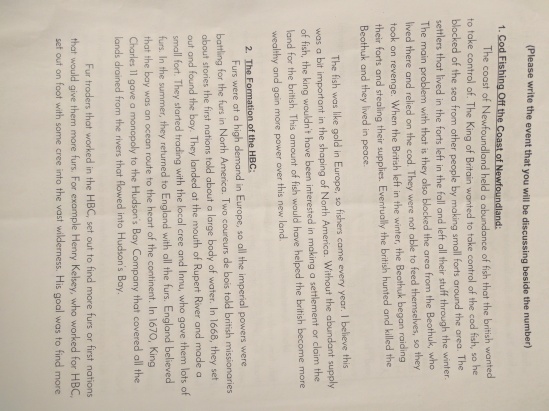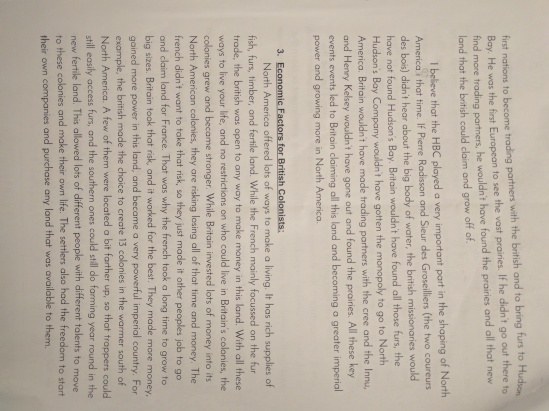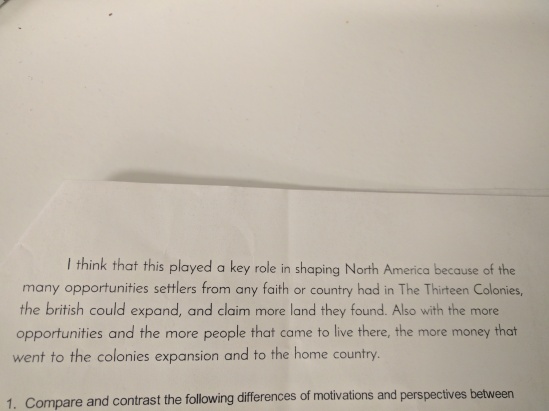Let me first say that I cannot believe how fast this year has gone by! It seems like it was just yesterday that I was walking into Greystone Centennial Middle School for the first time. Ecstatic to meet colleagues, see my room and start preparing for the year. This has been a year of incredible growth and development for me both personally and professionally. It has been one of the busiest years of my life, as well as the most rewarding. A whirlwind of change and learning has happened, I’ve been pushed and pulled in a million different directions and as the school year comes to a close the only thing I can think is “I can’t wait to do it again next year”. In reflecting upon how my first full year of teaching has gone I feel like an appropriate title for a post of this nature should be “Confessions of a First Year Teacher”.
Confession #1: You cannot prepare for the unexpected…
When I look back to day 1 of the school year, one thing comes to mind; nervous excitement! As I’m certain every other first year teacher did, I strolled into my compact (tiny), distraction free (windowless) classroom with robust confidence in my educational ability. Equipped with all the tools to be successful and supreme assurance in my university training, I welcomed the challenge of working with 24 wonderful pre-teens. Of course, underneath this facade I was more nervous than the bright-eyed 12 year olds that I welcomed with calm, cool and collected poise. Students streamed in and claimed their spots around the classroom, unsure of their new teacher, new grade and for some a new school. Like nervous gunmen from the old west, they stared tensely, each waiting for the other to make the first move. We dove in head first, together on this new adventure. What I quickly realized as we built classroom criteria together and co-created the expectations for the year, is that I was completely unprepared for what this year would entail. I have heard the adage often that one should always prepare for the unexpected. It quickly became evident how utterly false that statement is when it comes to maneuvering through the minefield of teenager emotional needs. I must have missed the course in university on managing emotional breakdowns, meeting demands for attention and avoiding one of a hundred possible privations in a day all while attempting to maintain a steady flow of curriculum content mixed with meaningful and authentic learning experiences. Nothing can prepare you for the endless stream of tasks. What I can confirm is that the whole process is exhilarating. Coming to the realization that I was completely ill-equipped was the first step of my rehabilitation. I made a contract with my students that I would always be willing to try new things, do my best, fail often, and learn from the experience. I told my students I would be a teacher who learned with them and from them. We were in this together and every student was enthusiastic about the transparency and willingness to embark on this adventure together. They don’t need (or want) a teacher who has an answer for everything and is prepared for every unforeseen circumstance They want someone who will be real with them, celebrate the successes, encourage the failures, laugh at their jokes, show interest in their stories and console them when their down and out. So do yourself a favor, don’t put any pressure on yourself and go with the flow, because try as hard as you might, you cannot prepare for the unexpected, but you can enjoy it.
Confession #2: DON”T “fake it till you make it”…
I really feel like there is a lot of pressure in this profession to pretend like you’ve got it all together all the time. The students expect you to have all the answers to life’s quandaries, parents want to know their child is in the most capable of hands, you want to create new, innovative approaches to learning and then there’s all the organization of IPPs, report cards, assessments and planning for the day. Meanwhile in either room beside yours is a 30 year veteran teacher who makes it all look easy. The tendency is to shut your door, labor through all of the work in solitude and then pretend like all is well when you step outside to do your rounds on supervision. Ignore those pesky lessons that fell flat and made a 50 minute block feel like forever, hide the fact that you had to spend 3 hours the previous night teaching yourself algebra because you don’t remember how to isolate the variable and personally withstand the onslaught of misbehavior because you hear from those 30 year veterans that they didn’t have any trouble keeping little Johnny in line. Fortunately I have been lucky enough to be at a school where collaboration isn’t only encouraged, it’s built into the schedule! The teachers support each other, discuss successes and failures and learn from one another. The doors are always open and everyone is always willing to listen with unjudging ears and prepared to share anecdotal stories from when they experienced similar downfalls. As a first year teacher I cannot express how much this has meant to me in terms of preserving my sanity. There has never been any pressure to fake it; in fact it has been the opposite. At Greystone we are encouraged to try things and inevitably fail. We as teachers spend countless hours impressing upon our students the confidence to be unafraid of failure; so why can’t we model those same attitudes? No one puts as much pressure on you as you put on yourself. So if there was one thing I would want to say it’s this; regardless of the school you are going to, whatever age you are, however many years you’ve been teaching, please don’t fake it till you make it. Open your doors, share everything, fail often and grow exponentially.
Confession #3: There’s more than one way to skin a cat…
In keeping the theme going of opening doors and collaborating, another thing I have learned this year is to be open to ALL new things. I still remember the narrow perception I had of education upon graduating university. I would teach the cores, all students would be excited about completing every assignment I gave them and everyone would finish their homework. So it was a learning experience to say the least when our principal approached our teaching team about dropping all the regular blocks as they were being taught and focus solely on science. Nervous trepidation is what I felt. Our team took on the challenge and began planning an inquiry process that would take our students through an intensive series of guided learning experiences constructed around the structures and forces science unit. Some of the greatest learning followed when all boundaries were broken down and students were allowed to immerse themselves in a field of study. Our team goal of ensuring student success by creating clear and purposeful learning intentions and shared success criteria as well as my personal goal of providing adequate time and support for focusing on the learning process rather than the product molded this project. The result was amazing; students were intrinsically motivated, completely engaged and overwhelmingly excited to learn in this way. My eyes were opened to the possibilities and I realized how powerful the learning could be when new and exciting approaches to learning were used. I started applying these principles to all areas and began to intentionally design inquiry based learning into every subject. Clear and guided expectations with goals for assignments co-created with the students. I spent way more time in feedback loops and formative assessment rather than focusing on finished products. Overall the quality dramatically increased as students became owners of their learning and proud of their work. I have tried many things this year that I would have never even thought of if it weren’t for the collaborative culture that abounds at Greystone. It is a characteristic of me now, an attitude I will take with me wherever I go.
Confession #4: At the end of the day, it is all about the students…
As I mentioned earlier, this has been the busiest year of my life. On top of trying to figure out this whole being a teacher bit, I moved houses (and cities) in the middle of the school year with a 10 month pregnant wife. I had my first child (I suppose that is obvious based on the previous statement), and went weeks surviving solely on coffee due to middle of the night feedings. I coached multiple sports and I volunteered at my church. It has been easy to see why teachers lose their passion and forget why we do what we do. I have experienced similar emotions when trying to cram in writing feedback on assignments between feeding and changing a new baby while trying to think what I will do with my class the next day and how I can talk to that certain student who is unmotivated and distracted by every little noise. Then I sit with a student and watch them have a light-bulb moment in math, or read a student’s beautiful breakdown of perspective and purpose on a social topic, or see a student’s astonished face when they complete a science experiment. I remember why I chose this profession when I go out and play some silly sport with my class or have them compete in a series of ridiculous challenges and everyone breaks down into laughter. I remember why I love getting up in the morning when a student takes a risk and does something unexpected or when they beg me to take a picture or film them doing something they’re proud of. I remember why this job is so important when I sit and listen to a student spill their guts about friends, their home life and their personal struggles and I help talk them through their difficult time. The relationships we as teachers build with our students can have profound and lasting effects and at the end of the day, it is the students that keep me coming back for more. While I know well the immense pressure of time and energy that is on us as teachers, I encourage everyone to spend time with your students outside of the classroom. Make time to discuss their hobbies and interests. Share your own personal experiences. Collect funny pictures of your students and celebrate successes with parents more often than you write about concerning misbehavior. These are the things that energize us and remind us why we chose the most rewarding profession there is.
Confession #5: Yes, I have lost a student’s work and made them do it again…
Besides the aforementioned offense, I have also called students the wrong names, wrongly accused others and completely overlooked other students misbehaving. I have told students I changed my mind (when actually I just forgot). I have had students video blog throughout an entire project, made the decision to wait until after Christmas to do something with those videos, only to find out that during the break they had erased the videos off of their computers and IPads. I have sent a group to go for a run just to get them out of my hair. I have spoken countless blunders and misspelled an alarming amount of words on the board. I have laughed, been astonished, shocked and even dismayed at some of the things my students have said. I have spent what felt like hours discussing with a student their behavior, left believing a real breakthrough had happened only to see that student do that exact same behavior the next day (or even next block in some cases). It feels like I have done it all and made every mistake in the book. But the funny thing is when I look back on all of these events, I am not disheartened or disillusioned, I am proud of the growth and accomplishments I have had this year and thrilled to explore the next chapter of the adventure. I am exhilarated over the ever-changing landscape of being a teacher and I can’t wait to see what next year will bring.






























